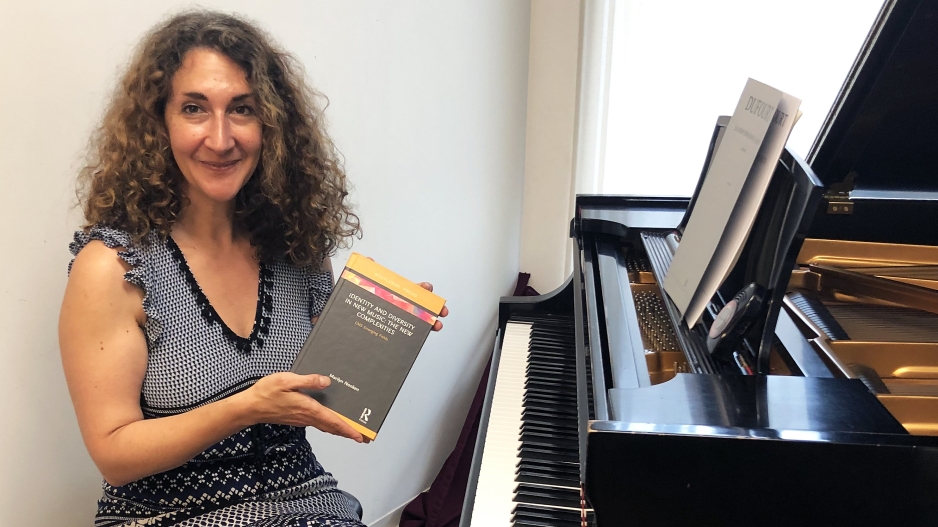Dr. Marilyn Nonken, Piano Studies program director, has published a new book, Identity and Diversity in New Music. She answered a few questions about the book and the topic of diversity in new music.

Dr. Marilyn Nonken holds a copy of her new book, "Identity and Diversity in New Music."
What inspired you to write this book?
In today's environments for the arts, performing musicians, music educators, and concert presenters are well-aware of the need be more diverse. So often, we're reminded of the imperatives to diversify our programming, our audiences, our faculties. Creativity, diversity, and integration are hot topics. However, in the musical environments in which I've found myself -- as a performer, teacher, administrator, curator, grant-giver, and grant seeker-- these terms are often under-defined and poorly understood, as are the very real benefits of diversity. Too often, this results in confusion and resentment among members of different communities, with different goals, values, and priorities. To those working in the arts, and particularly those who have not always considered how their work might relate to social justice, the bonuses of diversity aren't always clear. I thought it would be valuable to talk about what things like "diversity" and "identity" might mean, in terms of today's arts environments, from a practical standpoint.
What was lacking in new music performances?
Historically, there have always been challenges to introducing listeners to unfamiliar music. Since the beginnings of the twentieth century, composers and their interpreters have faced many challenges-- ranging from economic, political, and social obstacles to charges of elitism and "selling-out." How can we do what we do in a way that is meaningful to us and also meaningful to those not like us? These are perennial questions. In tracing the histories of four influential contemporary music groups from different eras and social contexts -- the Society for Private Musical Performance, the Group for Contemporary Music, L'Itinèraire, and Bang On A Can -- I sought to provide a historical context for the same questions confronted by today's performing artists.
How does a student's own identity impact his/her engagement with new music?
Identity is rich and manifold. Those teaching and performing music often don't take into account the richness and multifaceted nature of their students' identities, and the identities of their listeners and potential listeners. Identity subsumes aspects of race, ethnicity, and gender expression, but also education, class, religion, nationality, and physical ability... All of these factors influence how different musics become meaningful to us, in our own environments. To know why any music is meaningful to us, we must understand the specificities of our own environment and how music functions for us within it. To bridge with new audiences, and other communities, we must understand and respect the specificities of their environments and identities, and contemplate how music functions within their lives.
In a nutshell, how can musicians and educators made new music performances more inclusive?
We must creatively work to construct environments for music transformed by the presence of diversity on all levels: not only in terms of the composers whose music is being performed, but also in relation to the performers' bodies onstage, teachers in the classroom, listeners in the audience, and decision-makers in the boardroom and working behind the scenes. To reap the benefits of diversity, we must re-envision how we present music, designing musical environments that have the potential to be more robust and relevant. First, we must acknowledge the powerful factors that contribute to our own identities and tightly bonded communities. Then, by exploring those factors that contribute to the identities of others and communities not like ours, we will be able to create truly inclusive, vibrant, robust musical environments.
Read Dr. Nonken's related essay in 21CM.
-Caroline Lagnado Miller